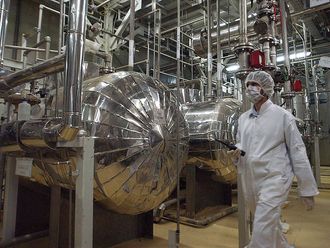
Washington: If anything could humanise Muammar Gaddafi, it was the before-and-after drama that emerged as images of the fallen dictator flooded Twitter, the internet and cable news.
One early bit of data pinging out of Sirte looked like a screen grab from a cell phone video, filled with telltale markings that suggest but don't assure authenticity: a time-and-date stamp, battery-level indicator, elapsed-time bar and play button on the bottom.
The dead Gaddafi was seen with half-open eyes, as if staring at the camera, bloodied but ashen, looking hauntingly like himself, but with the odd, theatrical mask of a white-faced geisha.
It felt real, but it had a strange, too-concentrated emotion. No matter how loathsome, a powerless person looking straight into the camera almost inevitably becomes sympathetic.
The images of the dead Gaddafi were reminiscent of a photo of Romanian dictator Nicolae Ceaucescu taken after his hasty execution in 1989.
Captured with his eyes open, the gray-haired tyrant looked natty in a red tie and blue jacket, and strangely handsome in a way that almost erased the memory of decades of brutal rule.
Jerky camera
It was an accidental envoi, an uncanny post-mortem appeal. Anyone new to the story on Thursday, seeing just that image of Gaddafi's lifeless face, with memories of the fake digital death mask of Osama Bin Laden that surfed the same networks of information and falsehood, had reason to be sceptical.
But there was also video of what appeared to be Gaddafi's bloodied body, filmed in the crowds-and-power style of accidental verite, the jerky camera, the bad focus, the manic efforts to frame and hold the image as humanity surges around the event.
Authenticity in the digital age is all about the feel of the image, the drama of how it seems to have been made.
Anything can be faked in our wag-the-dog world, but it's hard to fake this well this quickly. An image feels true not because it looks true (that's easy to do) but because it arrives in a way that feels true.
The need of angry Iraqis to see Saddam Hussain's execution might lead one to doubt the truth of the grainy film apparently captured during the execution. But it felt true because it seemed authentically purloined.
Perhaps the bloody face of terrorist leader Abu Musab Al Zarqawi, triumphantly displayed by the US military after he was killed in 2006, was mocked up with Photoshop.
But the beleaguered Bush administration's ham-fisted effort to celebrate Zarqawi's death like a war trophy — enlarging the photo, matting and framing it for a press conference — somehow made the image seem more genuine.
More is more, and speed matters in the authenticity game of digital imagery.
The self-reinforcing surge of Gaddafi images and video erased doubts. News websites and television called it for death, the headlines went big, the scrolling ticker was scrubbed of equivocations.
But Al Jazeera was also showing Gaddafi alive, in video apparently taken just before he was killed or expired from his wounds.
How did Gaddafi die? It's not hard to imagine. The missing images, paradoxically, become iconic. That gap, if it remains a gap, is almost assuredly being pondered in a sleek, brooding, hilltop palace above Damascus where another leader hangs on to power, and an erratic old man in Yemen.
— Washington Post












